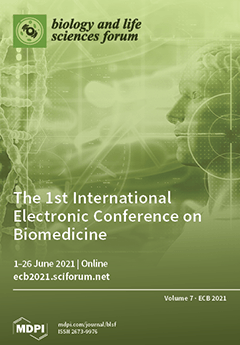Some studies demonstrate that gallic acid (GA) and myricetin (MYR) isolated from
Rhus trilobata provide the therapeutic activity of this plant against cancer. However, few reports demonstrate that both compounds could also have therapeutic potential in ovarian cancer. Therefore, evaluating the cytotoxic activity
[...] Read more.
Some studies demonstrate that gallic acid (GA) and myricetin (MYR) isolated from
Rhus trilobata provide the therapeutic activity of this plant against cancer. However, few reports demonstrate that both compounds could also have therapeutic potential in ovarian cancer. Therefore, evaluating the cytotoxic activity of GA and MYR against ovarian cancer cells and determining the possible action mechanism present are important. For this purpose, SKOV-3 cells (ovarian adenocarcinoma; HTB-77™, ATCC
®) were cultivated according to the supplier’s instructions (37 °C and 5% CO
2) to determine the biological activity of GA and MYR by confocal/transmission electron microscopy, PI-flow cytometry, H
2DCF-DA, MTT, and Annexin-V assays. Possible molecular targets of the compounds were determined by the Similarity Ensemble approach. Results showed that GA and MYR treatments decreased the viability of SKOV-3 cells at 50 and 166 μg/mL, respectively (
p ≤ 0.05, ANOVA vs. vehicle group). They also induced morphological changes (cytoplasmic reduction, nuclear chromatin condensation, cytoplasmic vesicles increment, polymerized actin, and stabilized tubulin), cell cycle arrest (GA: 8.3% G
2/M and MYR: 78% G
1), and apoptosis induction (GA: 18.9% and MYR: 8.1%), due to ROS generation (34 to 42%) for 24 h (
p ≤ 0.05, ANOVA vs. vehicle group). In silico studies demonstrated that GA and MYR interact with carbonic anhydrase-IX and PI3K, respectively. In conclusion, GA and MYR show cytotoxic activity against SKOV-3 cells through ROS production, which modifies the cytoskeleton and induces apoptosis. Therefore, GA and MYR could be considered as base compounds for the development of new treatments in chemotherapy for ovarian cancer.
Full article



